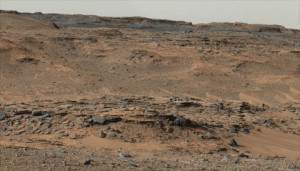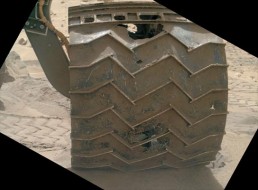Now two years into its exploration of Mars, NASA's beefy rover has reached the base of the huge mound that scientists hope will reveal the Red Planet's history.
Soon after NASA's Mars Science Laboratory, a.k.a. the Curiosity rover, descended to the floor of Gale crater two years ago, it returned panoramas showing a towering mountain nearby that is the mission's ultimate destination. Nicknamed "Mount Sharp" by the mission team (but formally known as Aeolis Mons), the massive mound is a stack of sedimentary layers that have been laid down over billions of years of Martian history.

NASA / JPL / MSSS
But like a kid who enters a toy store intent on buying just one must-have game, the mission team has moved the rover here and there — even directing it away from the mountain for a time — to explore all the tantalizing geologic features near its landing site.
Now, finally, the rover has arrived at the mountain's base and, within the next week, begin to climb into a cluster of mounds known as the Pahrump Hills. These lie in the Murray Formation, representing the lowermost slopes of what will be a long climb. The formation is about 200 meters thick, reports Kathryn Stack, the Curiosity rover mission scientist, potentially representing "millions to tens of millions of years of Martian history just waiting for us to explore."

NASA / JPL / MSSS / Emily Lakdawalla
Initially the mission's 400-strong scientific team had planned to spend even more time poking around curious outcrops on the crater's floor. However, there's growing concern about holes and tears in the 0.75-mm-thick aluminum skin covering Curiosity's six wheels. The damage first became obvious about a year ago, but a visual inspection last November showed a huge gash in the left-front wheel. (Sky & Telescope contributing editor Emily Lakdawalla details the wheel damage here.)
Since then, wear and tear on the wheels has been a constant concern, and at a NASA briefing yesterday mission scientist John Grotzinger announced plans to redirect the rover away from the planned route past geologically interesting outcrops called Murray Buttes, and onto a shorter and presumably safer path. Orbital imagery suggests that the Murray Formation displays few impact craters or layers, so it's probably relatively soft ground that will minimize wheel damage.
Thanks to decades of exploration, we already know a great deal about this intriguing neighboring world. Our special issue, "Mars: Mysteries & Marvels of the Red Planet," is loaded with spectacular photos and a must-read for anyone interested in Martian geology, the search for extraterrestrial life, and the future of human colonization of space.
Follow the exploits of Curiosity and other explorations of the Red Planet with Sky & Telescope's colorful, highly detailed Mars globe.
 4
4









Comments
Anthony Barreiro
September 12, 2014 at 6:30 pm
Thanks for this report, Kelly. I want to put in a plug for the Sky and Telescope special issue on Mars. I found it quite informative on every level -- understanding what I see through a telescope, the geology and history of Mars, the search for life, options for future exploration of Mars (I still believe we would get a lot more bang for our bucks if we send lots of robots rather than a human mission), etc. I learned a lot more about Mars from this well-illustrated special issue than from an introductory astronomy textbook.
You must be logged in to post a comment.
September 12, 2014 at 7:37 pm
Thank you for this update on Curiosity. I can't wait to see the geological features of Aeolis Mons and to finally see into Mars's past.
You must be logged in to post a comment.
Kevin
September 13, 2014 at 1:43 pm
AP/UPI - NASA announced today that a technician from AAA is on his way to Mars to repair damage to Curiosity's left front wheel. Dr. Joan Sampson, who is one of the rover's drivers said, "We truly hope that the AAA tech can get there in 9 or 10 months and get that wheel repaired because we still have a lot of Martian ground to cover. I'm just glad that NASA paid the AAA membership bill it received back in August because if they hadn't, the mission might have to be cancelled!"
You must be logged in to post a comment.
Lindsay
September 13, 2014 at 8:37 pm
Regarding wear and tear of Curiosity's wheels, next time consider putting a polyurethane/urea coating on the wheels (or HDPE) -- or do they need it to work at very low temperature?
You must be logged in to post a comment.
You must be logged in to post a comment.